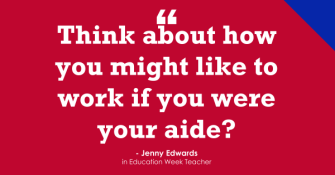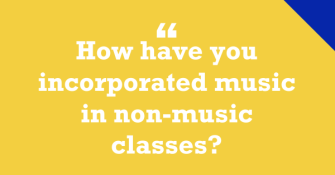(This is the final post in a three-part series. You can see Part One here and Part Two here.)
The new question-of-the-week is:
What are the best ways for teachers and aides to work together?
There are 3.2 million teachers in U.S. K-12 schools today. And there are also over 500,000 aides (also known as paraprofessionals) who work in instruction, primarily in early education, with students who have special needs, and with English-language learners.
This series will explore the most effective ways that teachers and aides (paraprofessionals) can work collaboratively....
In Part One, Rita Platt, Michele Morgan, Rachel Wright, and Dennis Griffin Jr. offered their suggestions. You can listen to a 10-minute conversation I had with Rita and Michele on my BAM! Radio Show. You can also find a list of, and links to, previous shows here.
In Part Two, Elizabeth Stein, Dr. Angela Peery, and Katrina Hankins contributed their commentaries.
Today, Cindy Terebush, Jenny Edwards, and Steve Peck share their thoughts.
The next question-of-the-week can also be found at the end of this post.
Teamwork
Cindy Terebush has an MS in early-childhood studies and is the author of Teach the Whole Preschooler: Strategies for Nurturing Developing Minds:
Teachers and aides need to work as a team. Children need to see that teachers and aides are partners. Teachers and aides can accomplish more when they work together.
Both teachers and aides need to be aware of the objectives for all lessons being taught. It would be beneficial for teachers and aides to meet each week to review the lessons and goals for the following week. All adults in the classroom should know the goals so they can all participate in taking observational notes about the children’s responses to activities.
Taking observational notes is the responsibility of all adults in the classroom. Because of the subjective nature of noting children’s actions and reactions, teachers need multiple perspectives to more effectively use observational notes to drive their teaching and their reports of progress for families.
Teachers and aides should spend time planning as well as debriefing about those plans after lessons occur. While they share a classroom, they have different experiences within the classroom. Each person’s knowledge is part of the whole of creating a cohesive classroom environment.
Working cooperatively and having their teamwork obvious to the children teaches social-emotional lessons. Children are always watching and evaluating the interactions in their world. Teachers and aides can provide the children with a wonderful example of teamwork and cooperation. They should communicate respectfully throughout the day, and the children should understand through their actions that the teacher and aide are working together to benefit everyone. They should be a model of adults seeking to learn from each other and adults understanding that they need others to succeed at higher levels.
As an early-childhood consultant, I know I have walked into a well-functioning early-childhood classroom when I am not initially sure of who is the teacher and who is the assistant. Early learners, particularly in the preschool years, do not know the difference between teachers and assistants. When we demonstrate that all adults in the classroom have value and are equally involved in their learning and well-being, the children are given a foundation for respecting all adults in their educational world for years to come.

Treat “your aide the way you would like to be treated”
Jenny Edwards teaches doctoral students in the School of Educational Leadership and Change at Fielding Graduate University in Santa Barbara, Calif. Edwards is the author of Time to Teach: How do I get organized and work smarter? (ASCD), Inviting Students to Learn: 100 Tips for Talking Effectively with Your Students (ASCD), and Research on Habits of Mind (2014, Institute for Habits of Mind International):
You have been assigned an aide to assist you in your classroom. What might be some strategies for working effectively with him/her? Think about how you might like to work if you were your aide? What might be important to you? You would probably want to be treated with respect and you would probably want to feel organized. You would probably want to have a clear idea of what the teacher wanted you to do. Be sure and ask your aide what he/she would like from you and how he/she would like to work. What might you be able to do to make it fun for your aide to come to work?
You might set aside a time to explain your classroom procedures and what you would like from your aide. Basically, treat your aide the way you would like to be treated. Be organized and treat him/her with respect.
A good way to work together is to write down everything you would like for your aide to do. Keep a list and add to it. For each item, you could have four columns. The first column would include the task. The next three columns could indicate when each task needs to be completed. The first column could be “Please do right away—need today.” The second one could be “Need for tomorrow.” The third column could be “Low priority—please do whenever you can.”
Next, let your aide know exactly where he/she can find things. Orient him/her to your files and other supplies. Explain your filing system and where items are stored. Give your aide a tour of the supply room in the school and orient him/her to the methods for obtaining items for you.
If your aide will be working with students, let your aide know what you expect from your students as well as your norms for working with them. What type of classroom management do you expect? Make sure your aide has the same expectations of students that you have as well as the same signals and ways of working with students.
Be sure and introduce your aide to your colleagues and other teachers in the school. Make sure he/she knows them and can call on them if needed.
Explain your sub folder and the information you provide for substitute teachers so that your aide can explain the procedures when you are gone.
Regularly, show appreciation to your aide. You might thank him/her for doing specific tasks. You could bring small gifts (i.e., a cinnamon roll, his/her favorite cup of coffee, a small gift, etc.) from time to time.
It might be good to check in with your aide from time to time to see how things are going. What might your aide like for you to do differently? What additional ideas might he/she have? By being organized and clear about your expectations, and by treating your aide the way you would like to be treated, you will develop a productive relationship that benefits everyone.

“Let your aides know that their suggestions and opinions are being heard”
Steve Peck is a special educator with over 15 years of experience working with students who have multiple and severe disabilities. He is a co-founder of The Connections Model, an SEL-focused education technology company whose KidConnect app and curriculum teach kids the fundamentals of emotional regulation:
It is tremendously important for teachers to have a positive working relationship with all of their aides. Aides are extremely important to a classroom and school system, and their value should never go unnoticed. Younger teachers just beginning their careers will learn how much their aides can assist them with the day-to-day workings of a classroom and school, in many cases because the aide may have been at the school already for many years. Showing an aide that they are valued by recognizing their hard work, opinions, suggestions, and time are all important ways for teachers and aides to build a professional relationship.
Let your aides know that their suggestions and opinions are being heard and often implemented in some fashion. This will go a long way to build their confidence when working with the students. Showing your knowledge in the subject matter will also allow them to see that they are learning from you while implementing your specific instructions or methods with the students.
Another important thing to remember when building a positive relationship with your aides is that they have personal and family lives. So many times, we as teachers develop personal relationships with our teacher colleagues because we spend a lot of time with them planning, meeting, and collaborating. However, we should be developing these types of personal relationships with our aides, as well, because we often spend as much if not more time with them. It’s amazing how much smoother a classroom runs when everyone feels valued. Showing interest and respecting boundaries goes a long way for your aides to feel comfortable with the teachers they are working with.
Aides should never feel intimidated by the teachers they are working with. A healthy professional relationship that involves respect from both sides goes a long way to ensuring a smooth classroom where students themselves are comfortable to learn because they feed off the comfort created by their teachers and aides.

Next “question-of-the-week”
The next question-of-the-week is:
How have you incorporated music in nonmusic classes?
Feel free to send in your responses!

Thanks to Jenny, CIndy, and Steve for their contributions!
Please feel free to leave a comment with your reactions to the topic or directly to anything that has been said in this post.
Consider contributing a question to be answered in a future post. You can send one to me at lferlazzo@epe.org. When you send it in, let me know if I can use your real name if it’s selected or if you’d prefer remaining anonymous and have a pseudonym in mind.
You can also contact me on Twitter at @Larryferlazzo.
Education Week has published a collection of posts from this blog, along with new material, in an e-book form. It’s titled Classroom Management Q&As: Expert Strategies for Teaching.
Just a reminder; you can subscribe and receive updates from this blog via email or RSS Reader. And if you missed any of the highlights from the first eight years of this blog, you can see a categorized list below. The list doesn’t include ones from this current year, but you can find those by clicking on the “answers” category found in the sidebar.
All Classroom Q&A Posts on the Coronavirus Crisis
This Year’s Most Popular Q&A Posts
Best Ways to Begin the School Year
Best Ways to End the School Year
Student Motivation & Social-Emotional Learning
Cooperative & Collaborative Learning
Teaching English-Language Learners
Entering the Teaching Profession
I am also creating a Twitter list including all contributors to this column.
